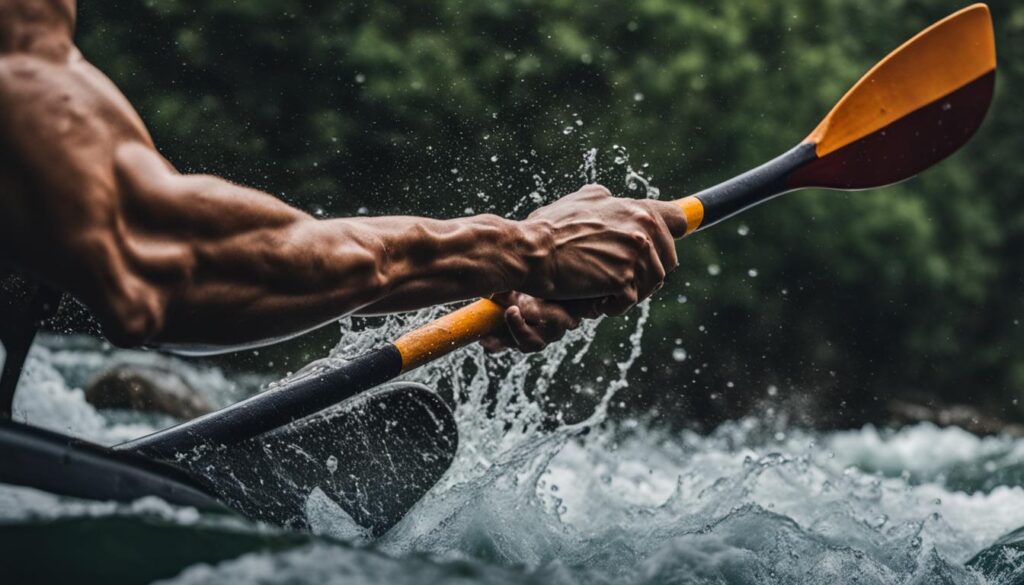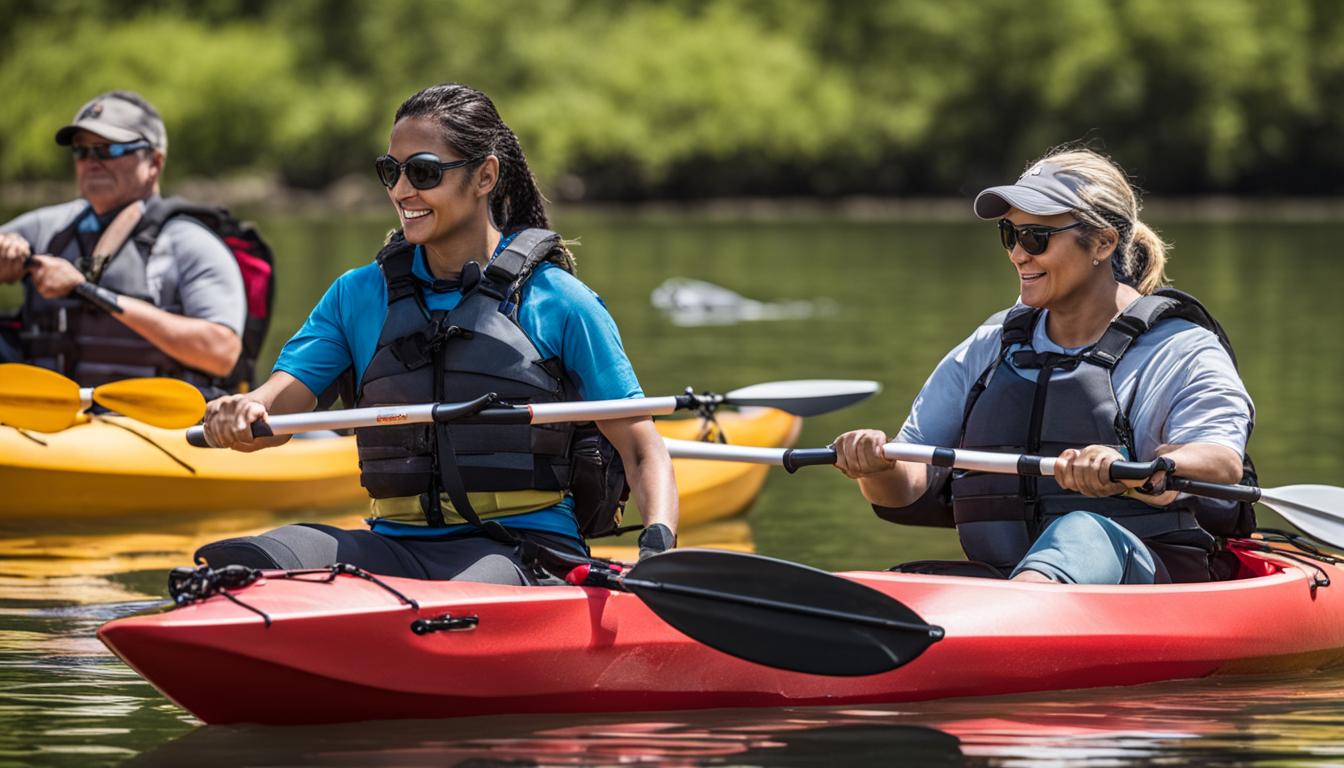Kayaking is a thrilling water sport that offers adventure, tranquility, and physical exercise. For kids who are interested in taking their kayaking skills to the next level, there are various advanced techniques and courses available. In this comprehensive guide, we will explore the benefits of encouraging kids to pursue advanced kayaking skills, the different courses and training options available, and how it can enhance their overall kayaking experience.
Key Takeaways
- Encouraging kids to pursue advanced kayaking skills can enhance their overall kayaking experience.
- There are various courses and training options available for kids to advance their kayaking skills.
- Mastering advanced kayaking techniques can provide adventure, tranquility, and physical exercise.
- It is important for kids to have a solid understanding of the basics of kayaking before advancing to more advanced techniques.
- Physical conditioning, optimal posture, and mastering different paddle strokes are key aspects of advancing kayaking skills.
Understanding the Basics of Kayaking
Before diving into advanced kayaking techniques, it’s essential for kids to have a solid grasp of the basics. Understanding the different types of kayaks and their suitability for different water conditions is the first step. Here are the most common types:
- Recreational Kayaks: Ideal for calm, flatwater environments like lakes and slow-moving rivers.
- Whitewater Kayaks: Designed for fast-moving rivers with rapids and obstacles.
- Sea Kayaks: Built for open water and coastal environments, offering stability and storage space.
- Touring Kayaks: Perfect for multi-day trips, providing efficiency and comfort.
Once your child understands the types of kayaks, the next step is to familiarize themselves with the necessary equipment. This includes a kayak paddle, personal flotation device (PFD), spray skirt (for whitewater kayaking), and appropriate clothing for the weather conditions. Teaching kids about water awareness is also crucial, ensuring they understand the importance of knowing their surroundings, being mindful of currents and tides, and respecting the natural environment.
Mastering basic paddling techniques is fundamental to kayaking. Here are a few key techniques your child should learn:
- Forward Stroke: The most basic stroke used for propelling the kayak forward.
- Sweep Stroke: Helps turn the kayak by sweeping the paddle wide across the water’s surface.
- Draw Stroke: Pulls the kayak sideways, useful for maneuvering in tight spaces.
- Bracing Stroke: Provides stability by using the paddle to keep the kayak from capsizing.
Lastly, body positioning plays a crucial role in kayaking. Kids should learn to sit with proper back support, maintain a relaxed grip on the paddle, engage their core muscles for stability, and practice torso rotation to generate power in their strokes. By mastering these basics, your child will have a solid foundation for advancing their kayaking skills.
| Type of Kayak | Water Conditions | Key Features |
|---|---|---|
| Recreational Kayaks | Calm, flatwater environments | Stability and ease of use |
| Whitewater Kayaks | Fast-moving rivers with rapids | Maneuverability and durability |
| Sea Kayaks | Open water and coastal environments | Stability and storage space |
| Touring Kayaks | Multi-day trips | Efficiency and comfort |
Importance of Physical Conditioning for Kayaking
Building physical strength and endurance is crucial for young kayakers looking to advance their skills. Physical conditioning not only enhances performance but also reduces the risk of injuries on the water. Here are the key areas of focus for optimal physical conditioning:
- Cardiovascular Fitness: Regular cardio exercises like running, swimming, or cycling help improve cardiovascular endurance, allowing kids to paddle for longer durations without exhaustion.
- Upper Body Strength: Kayaking requires strong arms, shoulders, and back muscles for steady paddling. Exercises like pull-ups, push-ups, and weightlifting can help develop upper body strength.
- Core Strength: A strong core stabilizes the body and provides power for paddle strokes. Including exercises like planks, sit-ups, and Russian twists can help strengthen the core muscles.
- Flexibility: Stretching exercises or activities like yoga improve flexibility, allowing kids to perform smooth and efficient movements in the kayak.
By incorporating these aspects of physical conditioning into their routine, young kayakers can enhance their performance, stamina, and overall kayaking experience.

Optimal Kayaking Posture
When it comes to kayaking, maintaining the correct posture is essential for both performance and safety. By adopting the optimal sitting position, foot position, back position, arm position, and incorporating torso rotation, kids can greatly enhance their kayaking experience.
| Posture Element | Optimal Position |
|---|---|
| Sitting Position | Avoid slouching and sit with your back straight against the backrest, ensuring proper support and posture alignment. |
| Foot Position | Position your feet firmly against the footpegs, allowing for stability and control over the kayak’s movements. |
| Back Position | Maintain a slight forward tilt in your upper body to engage your core and distribute your weight evenly. |
| Arm Position | Find a comfortable angle for your arms, allowing for efficient paddling and minimizing strain on your shoulders. |
| Torso Rotation | Engage in torso rotation as you paddle, using your core muscles to generate power and facilitate smooth strokes. |
By practicing and ingraining these postural techniques, kids can improve their paddling efficiency, prevent unnecessary strain on their body, and maintain better control over their kayak.
Remember, the proper kayaking posture not only enhances your performance but also reduces the risk of injuries. So, take the time to ensure you’re sitting correctly, maintaining proper foot and arm positions, and engaging your core through torso rotation. It may take some practice, but mastering the optimal kayaking posture will greatly benefit your overall kayaking experience.
Mastering Different Paddle Strokes
Once your child has a solid foundation in basic kayaking techniques, it’s time to introduce them to the various paddle strokes that will take their skills to the next level. Mastering these paddle strokes will not only enhance their control over the kayak but also improve their maneuverability and balance on the water.
The forward stroke is the most fundamental and essential stroke to master. It involves a smooth and efficient movement of the paddle through the water, propelling the kayak forward. Teaching your child the correct technique, emphasizing a proper rotation of the torso and utilizing the power of their core muscles, will ensure they can paddle effectively and cover greater distances with less effort.
The sweep stroke is used to turn the kayak quickly and efficiently. As the name suggests, the paddle sweeps from the bow to the stern or vice versa, creating a wide arc that propels the kayak in the desired direction. This stroke is especially useful when navigating tight corners or avoiding obstacles in the water. Encourage your child to practice this stroke on both sides of the kayak to improve their overall steering ability.
The draw stroke is another important technique that allows your child to move the kayak sideways. By placing the paddle blade parallel to the kayak’s side and pulling it towards them, they can control their lateral movement. This stroke is particularly useful for docking, maneuvering through narrow passages, or adjusting their position while fishing or taking photographs.
In addition to the forward stroke, sweep stroke, and draw stroke, your child should also learn the bracing stroke and sculling for support. The bracing stroke is used to maintain balance and stability in the kayak, preventing it from flipping over in rough or choppy waters. Sculling for support involves using a figure-eight motion with the paddle to maintain balance while stationary or moving slowly. These strokes are essential for building confidence and ensuring safety while kayaking.
By mastering these different paddle strokes, your child will become a more proficient and confident kayaker. Remember to practice these techniques in a controlled environment before venturing into more challenging waters. With time and experience, your child will gain the skills needed to tackle any kayaking adventure with ease.

Fundamental Paddle Strokes
| Paddle Stroke | Technique | Primary Purpose |
|---|---|---|
| Forward Stroke | Create forward propulsion by smoothly and efficiently moving the paddle through the water. | Move the kayak forward and cover distances with less effort. |
| Sweep Stroke | Sweep the paddle in an arc from bow to stern or vice versa to turn the kayak quickly. | Steer the kayak and navigate tight corners or avoid obstacles. |
| Draw Stroke | Place the paddle blade parallel to the kayak’s side and pull it towards you to move the kayak sideways. | Control lateral movement, adjust position, and maneuver through narrow passages. |
| Bracing Stroke | Quickly and firmly place the paddle blade in the water to maintain balance and stability. | Prevent the kayak from flipping over in rough or choppy waters. |
| Sculling for Support | Use a figure-eight motion with the paddle blade to maintain balance while stationary or moving slowly. | Stay balanced while stationary, maneuvering, or performing slow turns. |
Conclusion
Encouraging kids to pursue advanced kayaking skills is a fantastic way to enhance their kayaking proficiency. By providing progressive kayaking techniques for children, we can help them develop expert kayaking skills at a young age. This opens up exciting opportunities for elite kayaking training for young paddlers.
By investing in their training and providing the necessary support, parents can help their children excel in this thrilling water sport. Not only does it offer physical exercise and adventure, but it also nurtures their passion for kayaking and boosts their confidence on the water.
With advanced kayaking courses for kids, children can learn new techniques, overcome challenges, and experience the joy of mastering their skills. Creating a solid foundation of fundamental knowledge, physical conditioning, optimal posture, and mastering different paddle strokes will greatly enhance their overall kayaking experience.
So, whether your child is just starting their kayaking journey or already has some experience, don’t hesitate to explore the world of advanced kayaking. It’s an investment that will provide countless adventures, improve their proficiency, and cultivate a lifelong love for this incredible water sport.
FAQ
What are the benefits of encouraging kids to pursue advanced kayaking skills?
Encouraging kids to pursue advanced kayaking skills can enhance their kayaking proficiency, provide progressive training opportunities, develop expert skills at a young age, and offer elite training programs for young paddlers.
What should kids know before diving into advanced kayaking techniques?
Before diving into advanced kayaking techniques, kids should have a solid grasp of the basics, including understanding the different types of kayaks, familiarizing themselves with the necessary equipment, developing water awareness, mastering basic paddling techniques, and maintaining proper body positioning.
How important is physical conditioning for kayaking?
Physical conditioning is crucial for kayaking. It includes building cardiovascular fitness through regular cardio exercises, developing upper body strength, strengthening the core, and improving flexibility.
What is the correct posture for kayaking?
The correct posture for kayaking involves sitting with proper backrest support, positioning feet against the footpegs, maintaining a straight back and forward tilt, finding the right angle for the arms, and engaging in torso rotation for more efficient strokes.
What paddle strokes should kids master?
Kids should master a variety of paddle strokes, including the forward stroke, sweep stroke, draw stroke, bracing stroke, and sculling for support. Each stroke serves different purposes and improves maneuverability, balance, and overall kayaking skills.





